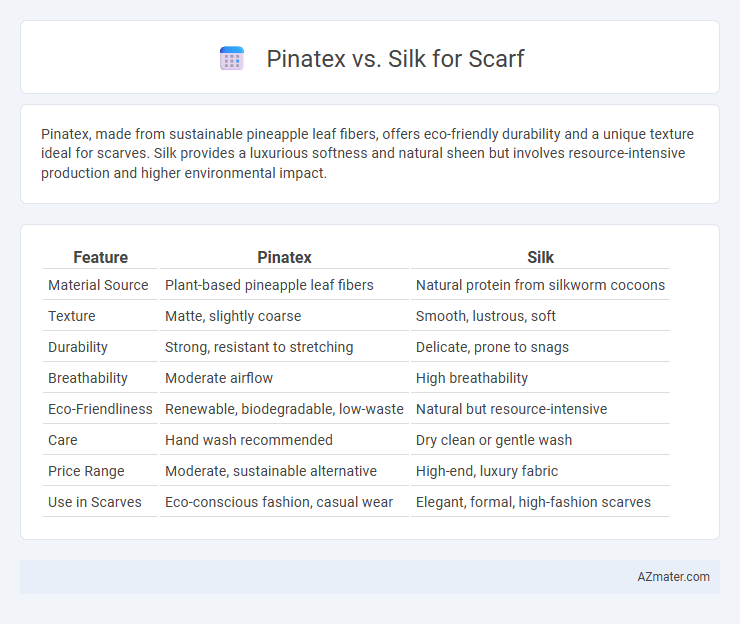Pinatex, made from sustainable pineapple leaf fibers, offers eco-friendly durability and a unique texture ideal for scarves. Silk provides a luxurious softness and natural sheen but involves resource-intensive production and higher environmental impact.
Table of Comparison
| Feature | Pinatex | Silk |
|---|---|---|
| Material Source | Plant-based pineapple leaf fibers | Natural protein from silkworm cocoons |
| Texture | Matte, slightly coarse | Smooth, lustrous, soft |
| Durability | Strong, resistant to stretching | Delicate, prone to snags |
| Breathability | Moderate airflow | High breathability |
| Eco-Friendliness | Renewable, biodegradable, low-waste | Natural but resource-intensive |
| Care | Hand wash recommended | Dry clean or gentle wash |
| Price Range | Moderate, sustainable alternative | High-end, luxury fabric |
| Use in Scarves | Eco-conscious fashion, casual wear | Elegant, formal, high-fashion scarves |
Introduction to Piñatex and Silk Scarves
Pinatex scarves are crafted from natural pineapple leaf fibers, offering a sustainable and cruelty-free alternative to traditional textiles. Silk scarves, made from the protein fibers produced by silkworms, are renowned for their smooth texture, luster, and luxurious feel. Both materials provide unique aesthetic qualities, with Pinatex emphasizing eco-friendly innovation and silk highlighting timeless elegance.
Origins and Production Processes
Pinatex, derived from pineapple leaf fibers, is an innovative sustainable textile created by extracting cellulose from agricultural waste, making it a zero-waste material primarily produced in the Philippines. Silk, known for centuries as a luxurious fiber, originates from the cocoons of silkworms through a labor-intensive process involving sericulture and careful harvesting of the silk threads. Pinatex's production emphasizes eco-friendly resource utilization and supports pineapple farmers, whereas silk production relies on traditional sericulture practices that demand significant natural resources and animal-based harvesting.
Sustainability and Environmental Impact
Pinatex scarves, made from pineapple leaf fibers, offer a sustainable alternative by utilizing agricultural waste and reducing reliance on water-intensive crops. Silk production involves significant environmental challenges, including high water consumption and the ethical concerns of silkworm farming. Choosing Pinatex supports eco-friendly practices and promotes renewable resources with a lower carbon footprint in textile production.
Texture and Comfort Comparison
Pinatex scarves offer a unique texture derived from pineapple leaf fibers, providing a slightly coarse yet flexible feel that becomes softer with wear. Silk scarves are renowned for their smooth, lustrous texture, delivering exceptional softness and a lightweight comfort ideal for sensitive skin. While Pinatex emphasizes sustainability and durability, silk excels in luxurious comfort and breathability, making both materials distinct choices for scarf enthusiasts.
Durability and Maintenance
Pinatex scarves, made from pineapple leaf fibers, offer exceptional durability with resistance to wear and tear, making them suitable for everyday use. These scarves require minimal maintenance, typically needing only gentle hand washing to preserve their texture and color. Silk scarves, while luxurious and smooth, demand more delicate care, such as dry cleaning or careful hand washing, and are prone to snagging and weakening over time with regular use.
Breathability and Moisture Management
Pinatex scarves, made from pineapple leaf fibers, offer superior breathability compared to traditional silk, allowing better air circulation and reducing heat build-up. The natural porous structure of Pinatex enhances moisture-wicking properties, effectively managing sweat and keeping the skin dry during wear. Silk, while smooth and lightweight, tends to retain moisture longer, making Pinatex a more practical choice for active use or warmer climates.
Color and Design Versatility
Pinatex scarves offer a natural matte finish with earthy tones, providing a unique, eco-friendly aesthetic ideal for rustic and bohemian styles. Silk scarves boast vibrant, lustrous colors and intricate patterns, giving unmatched design versatility suitable for both casual and formal wear. The choice hinges on desired texture and color intensity, with Pinatex emphasizing sustainability and subtlety, while silk highlights luxury and dynamic visual appeal.
Ethical Considerations
Pinatex is an innovative sustainable material derived from pineapple leaf fibers, supporting agricultural waste reduction and providing income for Filipino farmers, while being biodegradable and eco-friendly. Silk production involves silkworm farming, which raises concerns about animal welfare due to the killing of silkworms during harvesting, making it less ethical for vegan consumers. Choosing Pinatex for scarves aligns with cruelty-free and environmentally responsible fashion values, appealing to ethical and vegan-conscious buyers.
Price and Accessibility
Pinatex scarves are generally more affordable, ranging between $30 to $70, making them accessible to eco-conscious consumers seeking sustainable fashion alternatives. Silk scarves often start at $50 and can exceed $200, reflecting traditional luxury pricing and limited availability due to delicate sourcing and manufacturing processes. The widespread distribution of Pinatex products through ethical fashion retailers contrasts with silk scarves, which are primarily found in high-end boutiques and specialty stores.
Which Material is Best for Scarves?
Pinatex, made from pineapple leaf fibers, offers a sustainable and breathable option for scarves, providing a unique texture and lightweight feel suitable for everyday wear. Silk, renowned for its smoothness and natural hypoallergenic properties, excels in luxurious softness and temperature regulation, making it ideal for elegant and comfortable scarves. Choosing between Pinatex and silk depends on prioritizing eco-friendly durability versus traditional luxury and softness in scarf materials.

Infographic: Piñatex vs Silk for Scarf
 azmater.com
azmater.com